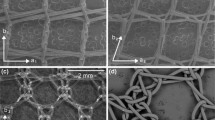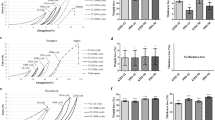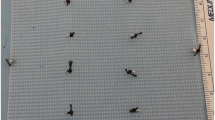Abstract
The aim of this study was to obtain information about the mechanical properties of six meshes commonly used for hernia repair (Surgipro®, Optilene®, Infinit®, DynaMesh®, Ultrapro™ and TIGR®) by planar biaxial tests. Stress-stretch behavior and equibiaxial stiffness were evaluated, and the anisotropy was determined by testing. In particular, equibiaxial test (equal simultaneous loading in both directions) and biaxial test (half of the load in one direction following the Laplace law) were selected as a representation of physiologically relevant loads. The majority of the meshes displayed values in the range of 8 and 18 (N/mm) in each direction for equibiaxial stiffness (tangent modulus under equibiaxial load state in both directions), while a few achieved 28 and 50 (N/mm) (Infinit ® and TIGR ®). Only the Surgipro ® mesh exhibited planar isotropy, with similar mechanical properties regardless of the direction of loading, and an anisotropy ratio of 1.18. Optilene ®, DynaMesh ®, Ultrapro ® and TIGR ® exhibited moderate anisotropy with ratios of 1.82, 1.84, 2.17 and 1.47, respectively. The Infinit ® scaffold exhibited very high anisotropy with a ratio of 3.37. These trends in material anisotropic response changed during the physiological state in the human abdominal wall, i.e. T:0.5T test, which the meshes were loaded in one direction with half the load used in the other direction. The Surgipro ® mesh increased its anisotropic response (Anis\(_{\text{Phys}}\) = 0.478) and the materials that demonstrated moderate and high anisotropic responses during multiaxial testing presented a quasi-isotropic response, especially the Infinit® mesh that decreased its anisotropic response from 3.369 to 1.292.



Similar content being viewed by others
References
Afonso, J., et al. Mechanical properties of polypropylene mesh used in pelvic floor repair. Int. Urogynecol. J. 19:375–380, 2008.
Alaedeen, D. I., et al. The single-staged approach to the surgical management of abdominal wall hernias in contaminated fields. Hernia 11:41–45, 2007.
Bellón, J. M. Role of the new lightweight prostheses in improving hernia repair. Cir. Esp. 85(5):268–273, 2009.
Bellón, J. M., et al. Comparison of a new type of polytetrafluoroethylene patch (Mycro Mesh) and polypropylene prosthesis (Marlex) for repair of abdominal wall defects. J. Am. Coll. Surg. 183:11–18, 1996.
Cobb, W. S., et al. Transmural organization of the arterial media. The lamellar unit revisited. J. Surg. Res. 136:1–7, 2006.
Deeken, C. R., et al. Physicomechanical evaluation of polypropylene, polyester, and polytetrafluoroethylene meshes for inguinal hernia repair. J. Am. Coll. Surg. 212:68–79, 2011.
Deeken, C. R., et al. A review of the composition, characteristics, and effectiveness of barrier mesh prostheses utilized for laparoscopic ventral hernia repair. Surg. Endosc. 26:566–575, 2012.
Deeken, C. R., et al. Biaxial analysis of synthetic scaffolds for hernia repair demonstrates variability in mechanical anisotropy, non-linearity and hysteresis. J. Mech. Behav. Biomed. 38:6–16, 2014.
Grashow, J. S., et al. Biaixal stress–stretch behavior of the mitral valve anterior leaflet at physiologic strain rates. Ann. Biomed. Eng. 34:315–325, 2006.
Hernández, B., et al. Mechanical and histological characterization of the abdominal muscle. A previous step to modelling hernia surgery. J. Mech. Behav. Biomed. 4:392–404, 2011.
Hernández-Gascón, B., et al. Mechanical behaviour of synthetic surgical meshes: finite element simulation of the herniated abdominal wall. Acta Biomater. 7:3905–3913, 2011.
Hernández-Gascón, B., et al. Long-term anisotropic mechanical response of surgical meshes used to repair abdominal wall defects. J. Mech. Behav. Biomed. 5:257–271, 2012.
Hernández-Gascón, B., et al. Mechanical response of the herniated human abdomen to the placement of different prostheses. ASME J. Biomech. Eng. 051004–1:433–444, 2013.
Hernández-Gascón, B., et al. Understanding the passive mechanical behavior of the human abdominal wall. Ann. Biomed. Eng. 41:433–444, 2013.
Klinge, U. Experimental comparison of monofile light and heavy polypropylene meshes: less weight does not mean less biological response. World J. Surg. 31:867–868, 2007.
Klinge, U., et al. Modified mesh for hernia repair that is adapted to the physiology of the abdominal wall. Eur. J. Surg. 164:951–960, 1998.
Klinge, U., et al. Impact of polymer pore size on the interface scar formation in a rat model. J. Surg. Res. 103:208–214, 2002.
Lanir, Y., and Y. C. Fung. Two-dimensional mechanical properties of rabbit skin-II. Experimental results. J. Biomech. 7:171–182, 1974.
Lichtenstein, I. L., and A. G. Shulman. Ambulatory outpatient hernia surgery including a new concept, introducing tension-free repair. Int. Surg. 71:1–4, 1986.
Lichtenstein, I. L., et al. The tension-free hernioplasty. Am. J. Surg. 157:188–193, 1989.
Lintin, L. A. D. , and A. N. Kingsnorth. Mechanical failure of a lightweight polypropylene mesh. Hernia 18:131–133, 2014.
Luijenkijk, R. W., et al. A comparison of suture repair with mesh repair for incisional hernia. N. Engl. J. Med. 343:392–398, 2000.
Morris-Stiff, G. J., and L. E. Hughes. The outcomes of nonabsorbible mesh paced within the abdominal cavity: literature review and clinical experience. J. Am. Coll. Surg. 186:352–367, 1998.
Pascual, G., et al. Early tissue incorporation and collagen deposition in lightweight polypropylene meshes: bioassay in an experimental model of ventral hernia. Surgery 144(3):427–435, 2008.
Podwojewski, F., et al. Mechanical response of animal abdominal walls in vitro: evaluation of the influence of a hernia defect and a repair with a mesh implanted intraperitoneally. J. Biomech. 46:561–566, 2013.
Podwojewski, F., et al. Mechanical response of human abdominal walls ex vivo: effect of an incisional hernia and a mesh repair. J. Mech. Behav. Biomed. 38:126–133, 2014.
Pott, P. P., et al. Mechanical properties of mesh materials used for hernia repair and soft tissue augmentation. PLoS ONE 7:e46978, 2012.
Rohrnbauer, B., and E. Mazza. Uniaxial and biaxial mechanical characterization of a prosthetic mesh at different length scales. J. Mech. Behav. Biomed. 38:6–16, 2014.
Saberski, E. R., et al. Anisotropic evaluation of synthetic surgical meshes. Hernia 15:47–52, 2010.
Sacks, M. Biaxial mechanical evaluation of planar biological materials. J Elast. 61:199–246, 2000.
Schachtrupp, A., et al. Individual inflammatory response of human blood monocyte to mesh biomaterials. Br. J. Surg. 90:114–120, 2003.
Song, C., et al. Mechanical properties of the human abdominal wall measured in vivo during insufflation for laparoscopic surgery. Surg. Endosc. 20:987–990, 2006.
Szymczaka, C., et al. Investigation of abdomen surface deformation due to life excitation: Implications for implant selection and orientation in laparoscopic ventral hernia repair. Clin. Biomech. 27:105–110, 2012.
Tong, J., et al. Effects of age on the elastic properties of the intraluminal thrombus and the thrombus-covered wall in abdominal aortic aneurysms: biaxial extension behaviour and material modelling. Eur. J. Vas. Endovasc. Surg. 42:207–219, 2011.
Usher, F. C., et al. A new technique for the reparir of inguinal and incisional hernias. Arch. Surg. 84:847–850, 1960.
Zuvela, M., et al. Central rupture and bulging of low-weight polypropylene mesh following recurrent incisional sublay hernioplasty. Hernia 18:135–140, 2014.
Acknowledgments
Financial support for this research was provided by the Spanish Ministry of Economy and Competitiveness through research projects DPI2011-27939-C02-01/DPI2011-27939-C02-02, DPI2014-54981-R and DPI2013-44391-P; the Department of Industry and Innovation (Government of Aragon) through the research group Grant T88 (Fondo Social Europeo) and the Instituto de Salud Carlos III (ISCIII) through the CIBER initiative (BIOMIMESH project) and the Platform for Biological Tissue Characterization of CIBER-BBN.
Declaration of interest
None of the authors has a financial or proprietary interest in any material or method mentioned. All the authors read and approved the final manuscript. The authors have no conflicts of interest to disclose.
Author information
Authors and Affiliations
Corresponding author
Additional information
Associate Editor Peter McHugh oversaw the review of this article.
Rights and permissions
About this article
Cite this article
Cordero, A., Hernández-Gascón, B., Pascual, G. et al. Biaxial Mechanical Evaluation of Absorbable and Nonabsorbable Synthetic Surgical Meshes Used for Hernia Repair: Physiological Loads Modify Anisotropy Response. Ann Biomed Eng 44, 2181–2188 (2016). https://doi.org/10.1007/s10439-015-1503-4
Received:
Accepted:
Published:
Issue Date:
DOI: https://doi.org/10.1007/s10439-015-1503-4




